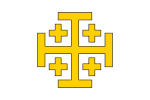Triarchy of Negroponte
| Triarchy of Negroponte | ||||||||||
| Nigropont | ||||||||||
| Client state* | ||||||||||
| ||||||||||
Negroponte (brown) and the other Greek and Latin states of southern Greece, ca. 1214 | ||||||||||
| Capital | Chalkis (Negroponte) | |||||||||
| Languages | Venetian officially, Greek popularly | |||||||||
| Religion | Roman Catholic officially, Greek Orthodox popularly | |||||||||
| Political structure | Client state | |||||||||
| Historical era | Middle Ages | |||||||||
| • | Principality established | 1204 | ||||||||
| • | Ottoman Conquest | 1470 | ||||||||
| ||||||||||
| * The duchy was nominally a vassal state of, in order, the Kingdom of Thessalonica, the Latin Empire (from 1209), the Principality of Achaea (from 1236), but effectively, and from 1390 also de jure, under Venetian control | ||||||||||
The Triarchy of Negroponte was a crusader state established on the island of Euboea (Italian: Negroponte) after the partition of the Byzantine Empire following the Fourth Crusade. Partitioned into three baronies (terzieri, "thirds") (Chalkis, Karystos and Oreos) run by a few interrelated Lombard families, the island soon fell under the influence of the Republic of Venice. From circa 1390, the island became a regular Venetian colony as the Kingdom of Negroponte (Regno di Negroponte).
History
Establishment
According to the division of Byzantine territory (the Partitio terrarum imperii Romaniae), Euboea was awarded to Boniface of Montferrat, King of Thessalonica. Boniface in turn ceded the island as a fief to the Flemish noble Jacques II of Avesnes, who fortified the capital Chalkis.
After his death in mid-1205 however, the island was ceded to three Veronese barons: Ravano dalle Carceri, Giberto dalle Carceri and Pecoraro da Mercanuovo. They divided the island into three triarchies (terzieri, "thirds"): the northern, based at Oreos (Italian: terzero del Rio), the southern, ruled from Karystos (Italian: terzero di Caristo) and the central portion, ruled from Chalkis (Italian: terzero della Clissura). The city of Chalkis or Negroponte (città de' Lombardi, "city of the Lombards") however was not under the latter's control, but served as overall capital of the island and joint residence of the Lombard rulers and their families. By 1209 however, Ravano had established himself as sole master of Euboea, styling himself as dominus insulae Nigropontis.
Having allied himself with an unsuccessful Lombard rebellion against the Latin Emperor, Henry of Flanders, Ravano was eager to find a powerful protector. Thus, in March 1209, he signed an alliance with Venice, which recognized Venetian overlordship and gave the Venetians significant commercial privileges. In May, however, in an act of political balancing, Ravano also acknowledged his vassalage to the Latin Empire.
Succession disputes

However, already after the death of Ravano in 1216, his heirs disagreed over the succession, allowing the Venetian bailo to intervene as a mediator. He partitioned the three baronies in two, creating thus six hexarchies (sestieri). The northern triarchy of Oreos was divided between Ravano's nephews, Marino I and Rizzardo; the southern triarchy of Karystos was divided between his widow, Isabella, and his daughter, Bertha; and the central triarchy was divided between Giberto's heirs, Guglielmo I and Alberto. Provisions were also made that in the case someone among the sestieri died, his inheritor would be the other sestiere of the respective triarchy, and not his children. In fact, most sestieri were succeeded by their brothers, sons or nephews, keeping the baronies within the tight circle of the original Lombard families.
In 1255 however, the death of Carintana dalle Carceri, hexarch of Oreos and wife to William II of Villehardouin, nominal overlord of Negroponte, led to the so-called "War of the Euboeote Succession", which involved the Principality of Achaea and Venice. William claimed for himself his wife's inheritance, while the Lombard barons were unwilling to concede it. On 14 June 1256, Guglielmo of Verona and Narzotto dalle Carceri, the other two triarchs, repudiated their allegiance to William and pledged themselves to Venice. William responded by capturing Chalkis, which the Venetians retook in early 1258. The war ended in the battle of Karydi in May/June 1258, where William defeated the Duke of Athens, Guy I de la Roche, who had allied himself with the rebellious triarchs. Finally, in August 1259, Doge Reniero Zeno negotiated a peace, followed by a treaty in 1262, which recognized William's suzerainty over the island, but not his possession of the triarchy of Oreoi.
Byzantine interlude
By that time, however, the Empire of Nicaea had established itself as the foremost power in the area of the former Byzantine Empire, reconquering several territories from the Latins. Its successes culminated in the recapture of Constantinople in 1261 and the reestablishment of the Byzantine Empire, whose energetic ruler, Michael VIII Palaeologus, sought to reconquer the remaining Latin principalities in southern Greece. To this end, he accepted the services of Licario, an Italian renegade, who had his base near Karystos. Under Licario's command, Byzantine troops soon conquered most of Euboea, except Chalkis.
After the departure of Licario sometime after 1280 however, with Venetian aid, the island gradually returned to Latin control.[1] By 1296, Bonifazio da Verona had completely expelled the Byzantines from Euboea.
Later history
In 1317 however, Karystos fell to the Catalan Company of Don Alfonso Fadrique, royal vicar-general (governor) of the duchy of Athens and illegitimate son of Frederick III of Sicily. In 1319, a peace treaty was signed between Venice and Don Alfonso, whereby he retained Karystos, which the Venetians acquired in 1365.
When the last triarchs, Niccolo III dalle Carceri and Giorgio III Ghisi, died in 1383 and 1390 respectively, they left their territories to Venice, which thus established complete predominance over the island. Nevertheless, the triarchic system was maintained, with Venetian families appointed to the positions of terzieri, while the Venetian podestà (magistrate) resided at Chalkis.
Venice's rule lasted until 1470, when, during the Ottoman–Venetian War of 1463–1479, Sultan Mehmed II campaigned against Chalkis. With the fall of the city on 12 July, the whole island came under Ottoman control. The city's fall is the subject of the Rossini opera Maometto II.
List of rulers of Negroponte
Note: The sequence of rulers during the 13th century, as well as the familial relations between them, are not very clear, as information about Euboea's internal history is scarce to non-existent, especially for the period 1216–1255.[2] According to the rules of succession laid down on the island's division into thirds and sixths in 1216, on the death of a hexarch, he was succeeded in his domain by his fellow hexarch within their third, and not by the former's heirs.[3] The following outline for the 13th century relies on the reconstruction by J.B. Bury.[4]
- Jacques d'Avesnes (1204–1205)
Triarchy of Chalkis
| dalle Carceri/da Verona family (Lombard) | |
|---|---|
| Giberto I da Verona(1205–1208) | |
| Ravano dalle Carceri (1209–1216) | |
| Guglielmo I da Verona (1217 – ca. 1263) | Alberto da Verona (1217 – before 1230) |
| Guglielmo I da Verona (1217 – ca. 1263) | |
| Guglielmo II da Verona (ca. 1263–1273/1275) | |
| Giberto II da Verona (1275–1279) | |
| Maria Navigajoso (1279–1328) | Beatrice da Verona (1279 – after 1310) and her husband John de Noyers (1303–1326) |
| Pietro dalle Carceri (1328–1340) | |
| Giovanni dalle Carceri (1340–1358) | |
| Niccolò dalle Carceri (1358–1383) | |
| Sommarippa family (under Venice) | |
| Maria II Sanudo (1383 – ?), with her husband Gaspare Sommaripa (1383–?) | |
| Crusino I Sommaripa (1430–1462) | |
| Domenico Sommarippa (1462–1466) | |
| Giovanni Sommarippa (1466–1468) | |
| Crusino II Sommarippa (1468–1470) | |
| Ottoman conquest (1470) | |
Triarchy of Karystos
| dalle Carceri family (Lombard) | |||||
|---|---|---|---|---|---|
| Ravano dalle Carceri (1205–1216) | |||||
| Isabella dalle Carceri (1216 – ?) | Berta dalle Carceri (1216 – ?) | ||||
| Grapella dalle Carceri (? – after 1262) | Narzotto dalle Carceri (before 1255 – before 1270) | ||||
| Gaetano da Verona | Marino II (Merinetto) dalle Carceri (before 1270–1278) under the regency of his mother Felisa da Verona | ||||
| Byzantine rule (1276–1296) | |||||
| Licario (1276 – ?) | |||||
| dalle Carceri/da Verona family | |||||
| Maria da Verona with her husband Andrea Cornaro |
Alice dalle Carceri with her husband George I Ghisi | ||||
| Peter dalle Carceri | Bartholomew II Ghisi | ||||
| Catalan rule | |||||
| Marulla da Verona (1317–1338) with her husband Alfonso Fadrique (1317–1338) | |||||
| Boniface Fadrique (1338–1365) | |||||
| Direct Venetian rule (1365–1386) | |||||
| Giustiniani family (under Venice) | |||||
| Michele Giustiniani (1386–1402) | Andrea Giustiniani (1386 – ?) | Giovanni Giustiniani (1386 – ?) | |||
| Antonio Giustiniani (? – 1406) | |||||
| Zorzi family (under Venice) | |||||
| Nicolò Zorzi (1406–1436) | |||||
| Jacopo Zorzi (1436–1447) | |||||
| Antonio Zorzi (1447–1470) | |||||
| Ottoman conquest (1470) | |||||
Triarchy of Oreos
| Percoraro de’ Percorari da Mercannuovo (1205–1209) | |||
| dalle Carceri family (Lombard) | |||
|---|---|---|---|
| Ravano dalle Carceri (1209–1216) | |||
| Rizzardo dalle Carceri (1216–1220) | Marino I dalle Carceri (1216 – before 1255) | ||
| Marino I dalle Carceri (1220 – before 1255) | |||
| Carintana dalle Carceri (? – 1255) | Narzotto dalle Carceri (before 1255 – after 1262) | ||
| Grapella dalle Carceri (1255 – after 1262) | |||
| Grapozzo dalle Carceri (before 1270 – ?) | Marino II (Merinetto) dalle Carceri (before 1270–1278) under the regency of his mother Felisa da Verona | ||
| Alice dalle Carceri (? – 1296) with her husband George I Ghisi (? – 1311) | |||
| Byzantine rule (1275–1280s) | |||
| Ghisi family | |||
| Peter dalle Carceri (about 1315) | Bartholomew II Ghisi (1311–1341) | ||
| George II Ghisi (1341–1358) | |||
| Bartholomew III Ghisi (1358–1384) | |||
| George III Ghisi (1384–1390) | |||
| d’Aulnay/de Noë family (under Venice) (1385–1470) | |||
| Januli I de Noë (1385–1394) | |||
| Nicolo de Noë (1394 – before 1426) | |||
| Januli II de Noë (before 1426–1434) | |||
| Gioffredo de Noë (1434–1446) | |||
| Januli III de Noë (1446–1470) | |||
| Ottoman conquest (1470) | |||
References
Sources and bibliography
- Bury, John Bagnell (1886). "The Lombards and Venetians in Euboia (1205–1303)". The Journal of Hellenic Studies. 7: 309–352. doi:10.2307/623649.
- Bury, John Bagnell (1887). "The Lombards and Venetians in Euboia (1303–1340)". The Journal of Hellenic Studies. 8: 194–213.
- Bury, John Bagnell (1888). "The Lombards and Venetians in Euboia (1340–1470)". The Journal of Hellenic Studies. 9: 91–117. doi:10.2307/623661.
- Cawley, Charles, Latin lordships in Greece: Euboea, Medieval Lands database, Foundation for Medieval Genealogy,
- Fine, John Van Antwerp (1994), The Late Medieval Balkans: A Critical Survey from the Late Twelfth Century to the Ottoman Conquest, University of Michigan Press, ISBN 978-0-472-08260-5
- Koder, Johannes (1973), Negroponte: Untersuchungen zur Topographie und Siedlungsgeschichte der Insel Euboia während der Zeit der Venezianerherrschaft (in German), Vienna: Verlag der Österreichischen Akademie der Wissenschaften, ISBN 3-7001-0020-5
- Miller, William (1908), The Latins in the Levant, a History of Frankish Greece (1204–1566), New York: E.P. Dutton and Company
- Nicol, Donald MacGillivray (1993), The Last Centuries of Byzantium, 1261–1453, Cambridge University Press, ISBN 978-0-521-43991-6
- Setton, Kenneth M. (1976), The Papacy and the Levant, 1204–1571: Volume I, The Thirteenth and Fourteenth Centuries, DIANE Publishing, ISBN 0-87169-114-0



